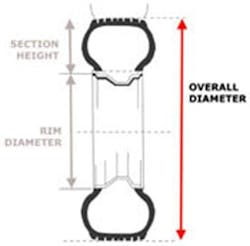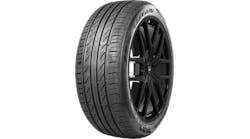The sidewall of a tire offers an abundance of information relative to size, maximum inflation, serial number, manufacturing location, tread wear rating, traction rating, rotational direction (if applicable), speed rating and more. In essence, this information serves as a very complete identification and, if you will, owner's manual for that specific tire.
Since much of this sidewall information can be confusing to your customers, here's information to help you explain the data provided that applies to a tire's dimensions.
Three sizing systems are employed today for passenger tires: P-metric, European metric and alpha-numeric.
The most common system is P-metric. The size designation indicates cross section in millimeters, aspect ratio, type of construction and appropriate rim diameter. For example, a P235/50R16 describes a tire that is intended for passenger use (P), and features a cross section width of 235mm, an aspect ratio of 50 and radial construction (R). It needs to be mounted to a 16-inch diameter wheel.
European metric, also called metric, is similar. No letter "P" is used as a prefix. The three-digit number at the beginning indicates cross section in millimeters. If the aspect ratio is lower than 82, the aspect ratio number will follow the section width number. If not, then no aspect ratio number will appear.
The next letter indicates the speed rating (sometimes the speed rating is included in a P-metric size after the aspect ratio). The R again refers to radial construction, and the final two-digit number indicates rim diameter in inches.
One example of a European metric tire size (with an 82 aspect ratio) is 155SR13, which indicates a 155mm section width, an S speed rating, radial construction, and a 13-inch wheel.
[PAGEBREAK]
Another example is 185/70SR14, which indicates a 185mm section width, a 70-series aspect ratio, a speed rating of S and radial construction, and use on a 14-inch diameter rim. A derivation of this is the millimetric tire, which simply features the rim diameter in millimeters instead of inches (example: 240/55VR390, where the 390 indicates a 390mm rim size). Michelin PAX tires feature sizing with the rim diameter in millimeters.
Alpha-numeric tires originated in the 1960s. This sizing system features a load-based identification approach, where the first letter designates the tire's load carrying capacity. For example, a BR60-13 tire features a "B" load rating, radial construction, a 60-series aspect ratio and a 13-inch rim requirement. The alpha (letter) character can range from A to N, depending on load capacity; the higher the letter, the higher the load rating.
Alpha-numeric sizes are in popular demand for "muscle car" restorations where the original size/type tire is desired. Of course, if an alpha-numeric-sized tire is not available, the customer will opt for a P-metric tire that features the same (or very close) overall diameter, aspect ratio and section width.
When plus-sizing to a larger diameter wheel, always maintain the size of the original tire's outside diameter.
Keeping the original tire diameter the same (or as close as possible) requires using a replacement tire with a shorter sidewall. It is important because it helps you avoid the following:
1. the need to recalibrate the speedometer.
2. confusing the ABS (if so equipped).
3. altering final drive ratio (which would change the engine speed and related power band use).
4. altering ride height (any desired ride height changes can be handled via suspension changes).
[PAGEBREAK]
Plus-sizing refers to the growth in wheel diameter. For example, a Plus-One indicates a move to a one-inch larger diameter wheel than stock. Plus-Two indicates a two-inch increase, and so on. Plus-sizing not only enhances appearance, but also puts more rubber on the road because the use of lower aspect ratio tires results in a greater section width and tread width.
The plus-sizing approach has been around for years, and remains a popular and sensible method of road tuning your customer's car. To determine just how large a Plus size is possible, follow the tiremaker's fitment guide whenever possible.
Light truck tire sizing can involve one of three sizing systems, including light truck metric, light truck high flotation and light truck numeric.
Light truck metric is very similar to the P-metric passenger tire system, with two simple additions. At the beginning, the letters "LT" indicate a light truck application. This is followed by the conventional P-metric designations including section width (mm), aspect ratio, construction type and rim diameter, followed by an alpha character which denotes load range. For example: LT235/75R15C.
Note that any tire that features an "LT" designation is designed for use on vehicles that may carry heavy loads and/or tow large trailers. This includes medium and heavy-duty pickup trucks (usually in the three-quarter-ton and one-ton truck range), full-size vans and some SUVs. LT tires provide increased reserve capacity to handle heavier cargo loads.
Light truck high flotation tires are designed with lower aspect ratios and are intended to provide increased traction in "loose" conditions such as sand and soft dirt. They are sized to clearly indicate tire diameter in inches, cross section in inches, construction type, rim diameter and load range, and carry a light truck identifier as well.
For example, size 31x10.50R15 LT/C indicates a 31-inch overall tire diameter, a cross section (section width) of 10.5 inches, radial construction, 15-inch wheel rim diameter, light truck designation, and a load range of C.
Light truck numeric is an older system, primary involving commercial vehicle applications. This sizing system identifies cross section in inches, construction type, rim diameter in inches, and denotes a light truck application and load range. For example, size 7.50R16LT/D refers to a radial light truck (LT) tire with a cross section width of 7.5 inches and a load range of D.
Tires identified as "ST" are "special trailer" tires, designed to only be used on trailers such as boat, car or utility trailers. They should never be used on passenger cars, vans, light trucks or SUVs.
[PAGEBREAK]
ASPECT RATIO IS... ?
Aspect ratio refers to the tire's section height in relation to its section width, as a percentage. For example, a 60-series tire features a sidewall that is 60% as tall as the tire's section width. A 50-series tire will feature a shorter sidewall, at 50% of section width. A 35-series tire will feature an extremely short sidewall (only 35% of section width), etc.
As a formula, aspect ratio equals the nominal section height divided by nominal section width times 100.
Example: If section height is three inches and section width is 10 inches, three divided by 10 x 100 = 30, which would mean that this tire features an aspect ratio of 30, making it a 30-series tire.
TIRE DIMENSION DICTIONARY
Overall diameter: the outside diameter of the tire when mounted and inflated, but with no vehicle load.
Section width: the maximum width of the tire's cross section of an unloaded, mounted and inflated tire (the widest point of the tire when mounted and inflated, but with no vehicle weight). It is also referred to as overall width.
Free radius: the radius of the tire/wheel assembly that isn't affected by load. It is the distance from the wheel axle centerline to the top of the tire tread face.
Loaded radius: the distance from the wheel axle centerline to the ground, drawn vertically. It is the distance from the vehicle hub centerline to the ground when the tire is inflated and when the tire supports vehicle weight.
Nominal wheel diameter: the size of the wheel applicable for mounting the tire (diameter of the rim seat that will support the tire bead). The bead-to-bead diameter is measured at the inside diameter of the tire, once mounted.
Section height: the distance from the bead to the tread face.
Loaded section height: the loaded radius minus half of the nominal rim diameter.
Aspect ratio: the tire's section height in relation to its section width, as a percentage.
Tread width: the distance measured from the inner tread shoulder to the outer tread shoulder. Tread width is not to be confused with section width, which is always greater.




